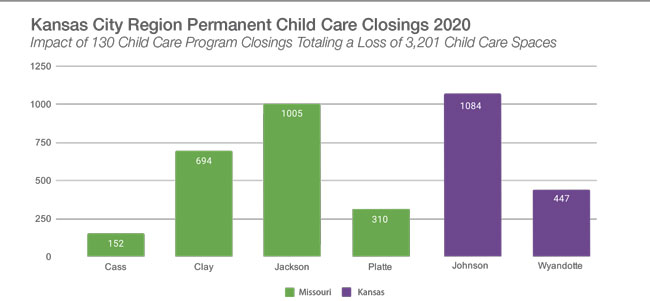Child Care Update
Is the child care sector surviving COVID-19?
The Pandemic Continues to Challenge Child Care Providers
We’re almost a year into the pandemic. For child care providers, that means a year of uncertainty — a year of increased operating costs (staff time and supplies), decreased revenue (closures and under enrollment), and stress.
Further, with school closures and new work routines, in many cases, parents have needed child care more than ever.
So where does the child care sector stand?
Throughout the pandemic, The Family Conservancy has been tracking program closures. To date, 130 programs in the Kansas City metropolitan area have reported they had permanently closed by the end of 2020. (This equates to a permanent loss of 3,201 child care spaces.) That represents a significant reduction in a vital resource that was already in short supply.

Beyond the permanent closures, not a single program in the metro has avoided the effects of the pandemic. We’ve heard from program owner-operators who have gone without a salary to keep their doors open and their team employed, home-based providers who are working double time to keep up with sanitization, and countless providers who have exhausted their savings during temporary closures and periods of reduced enrollment.
What is TFC doing to support child care?
The pandemic has weakened the already fragile child care sector, but this crisis has helped to spotlight the critical role child care plays in our community.
Through a partnership with Child Care Aware, TFC led an advocacy effort that enabled hundreds of community members to call on their elected officials, helping to secure much-needed pandemic relief funding for the early education sector. These funds have allowed many programs to stay afloat by enabling states to reimburse providers for COVID-related expenses and lost revenue.
In Wyandotte County, TFC was responsible for distributing CARES Act funding to child care providers. In December, 70 grants totaling over $261,000 were awarded to reimburse providers for COVID-related costs.
Amplifying our traditional role as leader and convener for the early education sector, in March, TFC assembled a group of community stakeholders to monitor supply and demand in the child care sector. We also created a resource library where providers access information; and the team hosted a series of webinars to promote best care practices during the pandemic.
What do child care providers still needed?
The crisis is far from over. In fact, it’s been going on far longer than the pandemic. Even in the best of times, child care programs are often barely scraping by — and only able to do so because early educators are seriously undercompensated. Similarly, home-based providers regularly work long hours for relatively little profit. Even still, the cost of care is still a significant burden for parents — leaving high-quality care out of reach for many families.
The reality is, we need more investment to survive the pandemic without a devastating loss of supply. It is likely that Congress will debate further investment in the child care sector soon. You can stay up-to-date and learn how to take action by signing up for our advocacy alerts.
While the pandemic has been a tragedy, we are hopeful this brings awareness to the longstanding issues that exist in early education – becoming a catalyst for long-term improvements in the child care sector. Together, we can create the equitable, high-quality child care sector our children, parents and our community needs.

